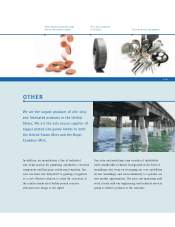Sunbeam 2002 Annual Report Download - page 21
Download and view the complete annual report
Please find page 21 of the 2002 Sunbeam annual report below. You can navigate through the pages in the report by either clicking on the pages listed below, or by using the keyword search tool below to find specific information within the annual report.Jarden Corporation
Management’s Discussion and Analysis (Continued)
future demand and market conditions. If actual market conditions are less favorable than those projected by us,
additional inventory write-downs may be required resulting in a charge to income in the period such
determination was made. Conversely, if actual market conditions are more favorable than those projected by us,
a reduction in the write down may be required resulting in an increase in income in the period such
determination was made.
Deferred tax assets
We record a valuation allowance to reduce our deferred tax assets to the amount that we believe is more
likely than not to be realized. While we have considered future taxable income and ongoing prudent and
feasible tax planning strategies in assessing the need for the valuation allowance, in the event we were to
determine that we would not be able to realize all or part of our net deferred tax assets in the future, an
adjustment to the deferred tax assets would be charged to income in the period such determination was made.
Likewise, should we determine that we would be able to realize our deferred tax assets in the future in excess
of our net recorded amount, an adjustment to the deferred tax assets would increase income in the period such
determination was made.
Intangible assets
We have significant intangible assets on our balance sheet that include goodwill, trademarks and other
intangibles fair valued in conjunction with acquisitions. The valuation and classification of these assets and the
assignment of amortizable lives involves significant judgments and the use of estimates. The testing of these
intangibles under established guidelines for impairment also requires significant use of judgment and
assumptions. Our assets are tested and reviewed for impairment on an ongoing basis under the established
accounting guidelines. Changes in business conditions could potentially require adjustments to these asset
valuations.
Contingencies
We are involved in various legal disputes in the ordinary course of business. In addition, the Environ-
mental Protection Agency has designated our Company as a potentially responsible party, along with numerous
other companies, for the clean up of several hazardous waste sites. Based on currently available information,
we do not believe that the disposition of any of the legal or environmental disputes our Company is currently
involved in will require material capital or operating expenditures or will otherwise have a material adverse
effect upon the financial condition, results of operations, cash flows or competitive position of our Company.
It is possible, that as additional information becomes available, the impact on our Company of an adverse
determination could have a different effect.
New Accounting Pronouncements
In July 2001, the Financial Accounting Standards Board (‘‘FASB’’) issued Statements of Financial
Accounting Standards (‘‘SFAS’’) No. 141, Business Combinations, and No. 142, Goodwill and Other Intangible
Assets, effective for fiscal years beginning after December 15, 2001. Under the new rules, goodwill and
intangible assets deemed to have indefinite lives are no longer amortized, but are subject to annual impairment
tests in accordance with the statements. Other intangible assets continue to be amortized over their useful lives.
We applied the new rules on accounting for goodwill and other intangible assets beginning in the first quarter
of 2002. We have performed the required tests of goodwill and indefinite lived intangible assets and, based on
the results, have not recorded any charges related to the adoption of and subsequent conformity with SFAS No.
142. In 2001 and 2000, we recorded goodwill amortization of $5.2 million and $6.4 million, respectively. The
adoption of SFAS No. 141 did not have a material impact on our results of operations or financial position.
In August 2001, the FASB issued SFAS No. 144, Accounting for the Impairment or Disposal of Long-Lived
Assets, effective for fiscal years beginning after December 15, 2001. This standard superceded Statement of
Financial Accounting Standard No. 121, Accounting for the Impairment of Long-Lived Assets and for
Long-Lived Assets to Be Disposed Of, and provided a single accounting model for long-lived assets to be
PG. 19
























